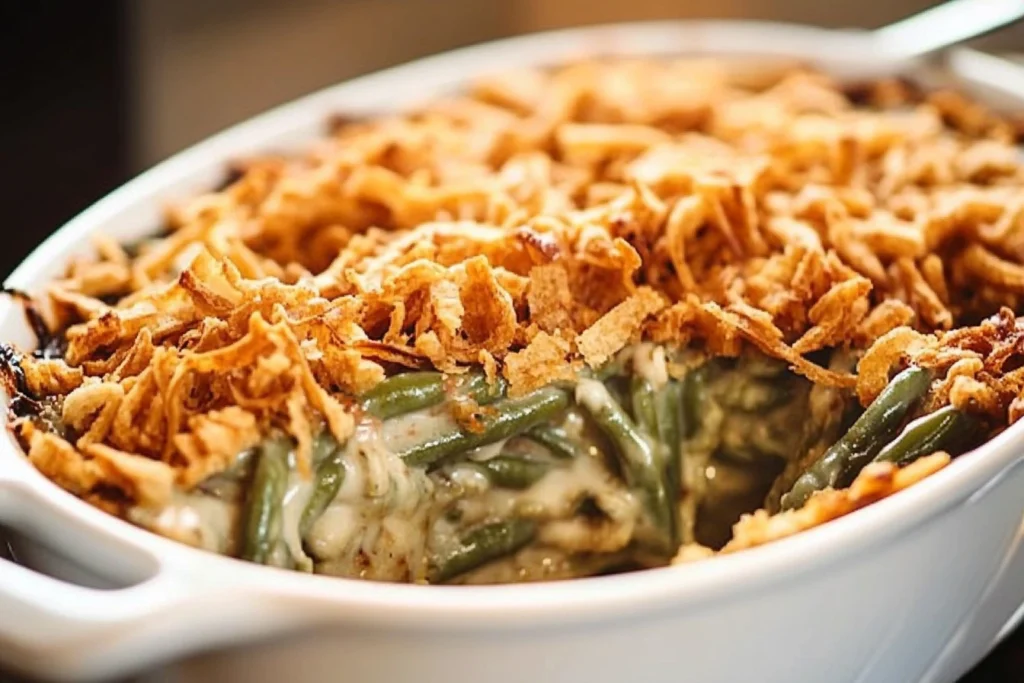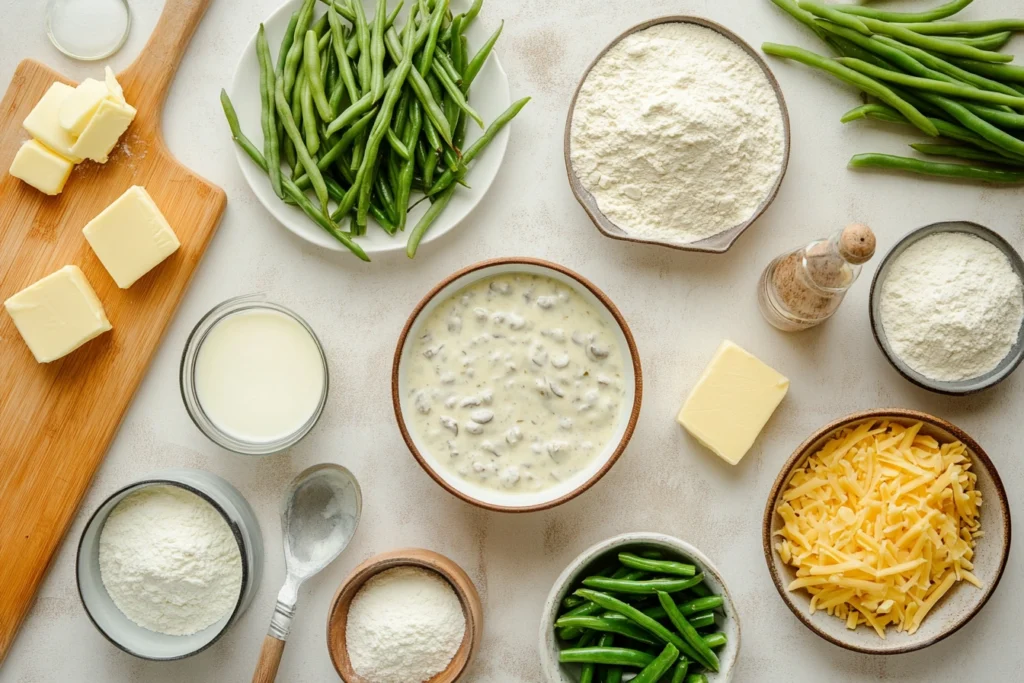Green bean casserole is a favorite dish at family gatherings, beloved for its creamy texture and flavorful combination of green beans, cream of mushroom soup, and crispy onions. However, achieving the perfect consistency can sometimes be tricky. A watery casserole can undermine your efforts, making the dish less enjoyable. If you’ve ever asked, “How can I thicken my green bean casserole?”, you’re not alone. This guide provides detailed, practical methods to create a perfectly thick and creamy casserole every time. By tweaking your ingredients, adding thickening agents, and avoiding common pitfalls, you can elevate this classic dish into a culinary masterpiece.

Table of Contents
Why Does Your Green Bean Casserole Need Thickening?
The hallmark of a great casserole is its creamy consistency. A thin or watery casserole not only looks unappetizing but can also fail to deliver the rich, comforting flavor that makes this dish so special. Understanding why your casserole might turn out runny is crucial to correcting the issue.
Common Causes of a Watery Casserole
- Excess liquid from green beans: Fresh, frozen, or canned beans can release water during the cooking process, thinning out the sauce.
- Overuse of milk or cream: Adding too much liquid dilutes the base, making it difficult to thicken.
- Skipping thickening agents: Some recipes may lack the necessary components to create a thick sauce.
- Improper cooking techniques: Baking at the wrong temperature or skipping critical steps can leave your casserole watery.
By identifying these causes, you can take the right steps to ensure your casserole has the perfect consistency. If you want to explore whether common ingredients like green beans or French fried onions could contain allergens, read this guide on does green bean casserole contain gluten?.
How Can I Thicken My Green Bean Casserole?

When asking yourself, “How can I thicken my green bean casserole?”, the solution often lies in one of three approaches: adjusting your ingredient ratios, incorporating thickening agents, or extending the cooking time. Let’s explore each method in detail to ensure your casserole is creamy and flavorful.
Adjusting the Ingredients to Thicken the Casserole
Your choice of ingredients and how you prepare them can make a significant difference in the thickness of your casserole. Adjusting ingredient ratios is one of the simplest ways to fix a watery casserole.
Reduce Liquid Content
One common mistake is adding too much liquid. Here’s how to avoid it:
- Drain the green beans thoroughly: Whether you’re using canned or frozen beans, ensure they are well-drained before adding them to the mix.
- Use less milk or soup: Cut back on the liquid components of your recipe to maintain a thicker base. Start with the recipe’s suggested amounts, then reduce as needed.
Increase Creamy Components
Boosting the creamy ingredients can naturally thicken your casserole:
- Replace regular milk with heavy cream or half-and-half for a richer, thicker consistency.
- Add an extra scoop of cream of mushroom soup to the mixture for a more substantial base.
Incorporate Cheese
Cheese adds both flavor and texture:
- Mix shredded cheddar or mozzarella into the casserole to create a gooey, creamy texture.
- Sprinkle Parmesan on top before baking for a thick, cheesy crust.
These ingredient adjustments can make a significant difference in the final texture of your dish.
Using Thickening Agents for a Perfect Texture

Thickening agents are reliable solutions for achieving a creamy casserole. They work quickly and don’t significantly alter the flavor, making them an ideal choice when your dish needs a boost.
Cornstarch Slurry
- Mix 1 tablespoon of cornstarch with 2 tablespoons of cold water until smooth.
- Stir the slurry into your casserole mixture before baking for a silky, thick texture.
Flour Roux
- Melt 1 tablespoon of butter in a pan and whisk in 1 tablespoon of flour until it forms a smooth paste.
- Cook the roux for 1-2 minutes, then mix it into your casserole. This method adds richness and thickness.
Instant Mashed Potato Flakes
- Add 1-2 tablespoons of instant mashed potato flakes to the casserole.
- Stir until the desired consistency is achieved. Be cautious not to overdo it, as the flakes can thicken quickly.
Gluten-Free Alternatives
For those avoiding gluten, try these alternatives:
- Arrowroot powder: A neutral-flavored thickener that works like cornstarch.
- Tapioca starch: Another gluten-free option that thickens without clumping.
Using the right thickening agent ensures your casserole has a creamy, cohesive texture.
How to Prevent a Watery Green Bean Casserole
Preventing issues before they arise can save time and frustration. Follow these tips to avoid common pitfalls:
- Precook the Green Beans: Blanch or steam fresh green beans to remove excess water before adding them to the casserole.
- Bake at the Right Temperature: Cook at 350°F (175°C) to allow the sauce to thicken without curdling.
- Use a Thick Base: Ensure your sauce is thick and creamy before combining it with the green beans.
Taking these precautions helps your casserole maintain its structure and appeal.
How Can I Fix a Runny Green Bean Casserole After Baking?
Sometimes, even the best preparations result in a watery casserole. Here’s how to fix it after baking:
- Extend the Baking Time: Bake the casserole for an additional 10-15 minutes at 350°F to allow excess moisture to evaporate.
- Add a Thickening Agent: Remove the casserole from the oven, stir in a cornstarch slurry or potato flakes, and bake again for a few minutes.
- Simmer on the Stovetop: Transfer the mixture to a saucepan and simmer on low heat until the liquid reduces.
These quick fixes can rescue your dish and ensure it’s ready to serve.
Layering Techniques to Improve Texture
Strategic layering can enhance the overall consistency of your casserole. Follow this method for the best results:
- Base Layer: Start with a thick sauce at the bottom of the baking dish.
- Middle Layer: Add green beans evenly to prevent pockets of moisture.
- Top Layer: Finish with crispy fried onions or breadcrumbs for added texture and a golden crust.
This approach ensures each bite is balanced and delicious.
Mistakes to Avoid When Thickening Your Green Bean Casserole
Avoiding these common mistakes can save you from a watery or overly thick casserole:
- Adding Excess Liquid: Stick to the recipe’s recommended amounts for milk and soup.
- Skipping Thickening Steps: Ensure you include a thickening agent or adjust the sauce consistency.
- Overmixing: Stir the casserole gently to maintain the structure of the green beans and sauce.
By steering clear of these errors, you’ll achieve a consistently creamy dish.
Conclusion
Mastering the perfect texture for your green bean casserole is simple with the right techniques. From adjusting ingredient ratios to incorporating thickening agents and avoiding common mistakes, there are numerous ways to ensure a creamy and delicious result. Next time you ask yourself, “How can I thicken my green bean casserole?”, you’ll have all the tools and knowledge you need. With a little preparation, your casserole will be the highlight of any meal, earning you rave reviews every time.
For variations like gluten-free green bean casseroles, check out this helpful article: how to make gluten-free green bean casserole.
Happy cooking!
FAQs
What to Do If Green Bean Casserole Is Too Watery?
If your green bean casserole is too watery, you can address the issue by:
Baking Longer: Extend the baking time by 10-15 minutes to evaporate excess liquid.
Adding a Thickening Agent: Stir in a cornstarch slurry (1 tablespoon cornstarch + 2 tablespoons cold water) and bake for a few more minutes.
Draining the Beans Thoroughly: If you used canned or frozen beans, ensure they are well-drained before adding them to the casserole.
Simmering on the Stovetop: Transfer the mixture to a pan and simmer on low heat to reduce the liquid.
What to Do If Casserole Is Too Runny?
When a casserole is too runny:
Add More Creamy Ingredients: Mix in extra cream of mushroom soup or heavy cream to thicken the sauce.
Incorporate Cheese: Stir in shredded cheese to create a denser texture.
Use Mashed Potato Flakes: Sprinkle 1-2 tablespoons of instant mashed potato flakes into the casserole and mix gently.
Recheck Ratios: Make sure the liquid-to-solid ratio is balanced. Reduce the amount of milk or broth in future attempts.
How Do You Thicken Bean Casserole?
To thicken bean casserole:
Use flour or cornstarch: Make a slurry with 1 tablespoon of the thickener and 2 tablespoons of cold water, then stir it into the casserole.
Add instant mashed potato flakes: A quick fix that blends seamlessly into the dish.
Increase creamy components: Add extra soup, cream, or cheese.
Bake longer: Allow the casserole to thicken naturally as liquid evaporates.
How Do You Thicken a Casserole After Cooking?
If your casserole is already cooked but still runny:
Simmer on the Stovetop: Transfer the mixture to a pan and cook on low heat until the liquid reduces.
Stir in a Thickener: Add a cornstarch or flour slurry, stirring constantly until the casserole thickens.
Bake Again: Place it back in the oven for an additional 10-15 minutes.
Add Breadcrumbs or Crushed Crackers: Sprinkle on top and mix to absorb excess moisture.


5 thoughts on “Best Ways to Thicken Green Bean Casserole (Simple and Quick Tips)”